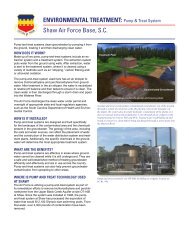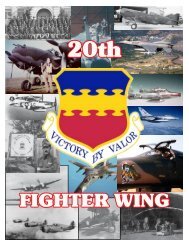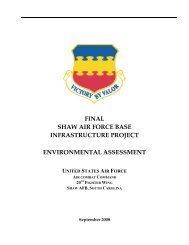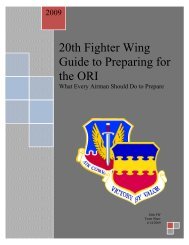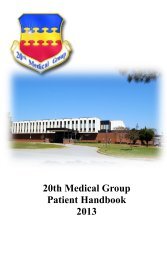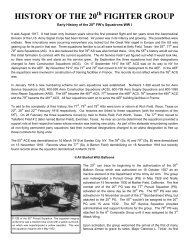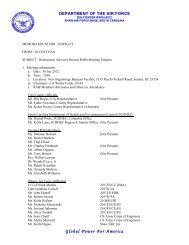HISTORY OF THE 20th FIGHTER WING - Shaw Air Force Base
HISTORY OF THE 20th FIGHTER WING - Shaw Air Force Base
HISTORY OF THE 20th FIGHTER WING - Shaw Air Force Base
You also want an ePaper? Increase the reach of your titles
YUMPU automatically turns print PDFs into web optimized ePapers that Google loves.
first commander, led the group until 13 October 1932. Major Tinker, part Osage Indian, gained fame as Major<br />
General Tinker, World War II Commander of the Seventh <strong>Air</strong> <strong>Force</strong> in the Pacific Theater. Tinker <strong>Air</strong> <strong>Force</strong> <strong>Base</strong>,<br />
Oklahoma, was named in his honor a year after his death during the Battle of Midway in 1942.<br />
The first combat aircraft of the 20 PG was a P-12 with serial number 29-355 assigned to the 77 PS. The group’s<br />
P-12s were single-seat biplane fighters that featured two .30 caliber machine guns, an open cockpit, a 500<br />
horsepower Pratt and Whitney engine, and a top speed of 180 miles per hour.<br />
On 15 May 1931 the 20 PG made a cross-country trip while going on maneuvers. These maneuvers were<br />
part of the first of its kind for the <strong>Air</strong> Corps. “The Great <strong>Air</strong> Armada” put on shows in Chicago, NY, Boston, and<br />
Washington, DC. The maneuvers consisted of all <strong>Air</strong> Corps aircraft with the exception of basic trainers, around<br />
640 aircraft.<br />
To Barksdale By Sea<br />
The Group remained at Mather Field for a little less than two years until 15 October 1932. On that date an advance<br />
party of more than 200 officers, enlisted men, and their dependents, under the command of Captain Thomas<br />
Boland, sailed from San Francisco aboard the USS Grant.<br />
They traveled through the Panama Canal and debarked<br />
at New Orleans, Louisiana, on 30 October 1932. On the<br />
following day, they arrived at Barksdale Field, Louisiana. The<br />
55 PS’s P-12s arrived at Barksdale on the same day. The 77<br />
PS followed suit on 15 November 1932.<br />
USS Grant used to transport the 20 th Pursuit Group from<br />
San Francisco to New Orleans via the Panama Canal.<br />
The 20 th had hardly settled at Barksdale Field when, on 7 November<br />
1932, it took part in its first tactical pursuit exercise from the new<br />
base. En route to Fort Crockett, its 27 P-12s engaged in mock<br />
aerial warfare over Beaumont, Texas. By February 1933 when<br />
Barksdale Field was formally dedicated, the group’s training<br />
program was in full operation. Its aerial training mission focused<br />
on the development of procedures and techniques for engaging<br />
enemy aircraft and provided for the protection of vital industrial<br />
centers, airdromes, and bombardment aircraft. The 79 PS joined<br />
on 1 April 1933.<br />
In October 1934, the group (by then three flying squadrons strong)<br />
made its first aircraft transition from the P-12 to the Boeing P-26<br />
Peashooter. This open cockpit monoplane had a 600 horsepower<br />
engine and a top speed of 253 miles per hour. Like the P-12, it<br />
possessed two .30 caliber machine guns. Unlike its predecessor,<br />
it also featured wing-mounted bomb racks.<br />
In February 1935, the 20 PG was joined at Barksdale by the 3 rd<br />
Attack Wing and 3 rd Attack Group. Joint operations by the two<br />
combat groups were highlighted in 1937 by their participation in<br />
two aerial demonstrations, the first on behalf of the Command<br />
Major Millard F. Harmon, first commander of the newly<br />
opened Barksdale Field, took over command of the 20 PG on<br />
its arrival at Barksdale. Just prior to its transfer to Barksdale,<br />
the group was assigned, along with the 3 rd Attack Group, to<br />
the 3 rd Attack Wing in June 1932. The 3 rd Attack Wing and<br />
Group operated out of Fort Crockett, Texas.<br />
20 th Fighter Wing History --- Page Number .<br />
P-26A of the 77 th Pursuit Squadron. 20 th Pursuit<br />
Group P-26 aircraft did not have squadron markings.<br />
To identify them the cowl ring had a red scallop with<br />
a white strip and the engine face was also red. Similar<br />
paint scheme would be used for the 55 th and 79 th<br />
squadrons with their respective colors. Also note the<br />
long tube in front of the windscreen. This was the<br />
telescopic gun sight. The aircraft was armed with<br />
a pair of .30 caliber machine guns firing through the<br />
prop from below the fuselage.



